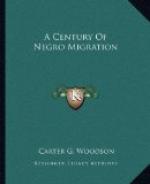In the same way the free Negroes met discouragement in Illinois. They suffered from all the disabilities imposed on their class in Ohio and Indiana and were denied the right to sue for their liberty in the courts. When there arose many abolitionists who encouraged the coming of the fugitives from labor in the South, one element of the citizens of Illinois unwilling to accept this unusual influx of members of another race passed the drastic law of 1853 prohibiting the immigration. It provided for the prosecution of any person bringing a Negro into the State and also for arresting and fining any Negro $50, should he appear there and remain longer than ten days. If he proved to be unable to pay the fine, he could be sold to any person who could pay the cost of the trial.[35]
In Michigan the situation was a little better but, with the waves of hostile legislation then sweeping over the new[36] commonwealths, Michigan was not allowed to constitute altogether an exception. Some of this intense feeling found expression in the form of a law hostile to the Negro, this being the act of 1827, which provided for the registration of all free persons of color and for the exclusion from the territory of all blacks who could not produce a certificate to the effect that they were free. Free persons of color were also required to file bonds with one or more freehold sureties in the penal sum of $500 for their good behavior, and the bondsmen were expected to provide for their maintenance, if they failed to support themselves. Failure to comply with this law meant expulsion from the territory.[37]
The opposition to the Negroes immigrating into the new West was not restricted to the enactment of laws which in some cases were never enforced. Several communities took the law into their own hands. During these years when the Negroes were seeking freedom in the Northwest Territory and when free blacks were being established there by philanthropists, it seemed to the southern uplanders fleeing from slavery in the border States and foreigners seeking fortunes in the new world that they might possibly be crowded out of this new territory by the Negroes. Frequent clashes, therefore, followed after they had passed through a period of toleration and dependence on the execution of the hostile laws. The clashes of the greatest consequences occurred in the Northwest Territory where a larger number of uplanders from the South had gone, some to escape the ill effects of slavery, and others to hold slaves if possible, and when that seemed impossible, to exclude the blacks altogether.[38] This persecution of the Negroes received also the hearty cooperation of the foreign element, who, being an undeveloped class, had to do menial labor in competition with the blacks. The feeling of the foreigners was especially mischievous for the reasons that they were, like the Negroes, at first settled in large numbers in urban communities.
Generally speaking, the feeling was like that exhibited by the Germans in Mercer County, Ohio. The citizens of this frontier community, in registering their protest against the settling of Negroes there, adopted the following resolutions:




